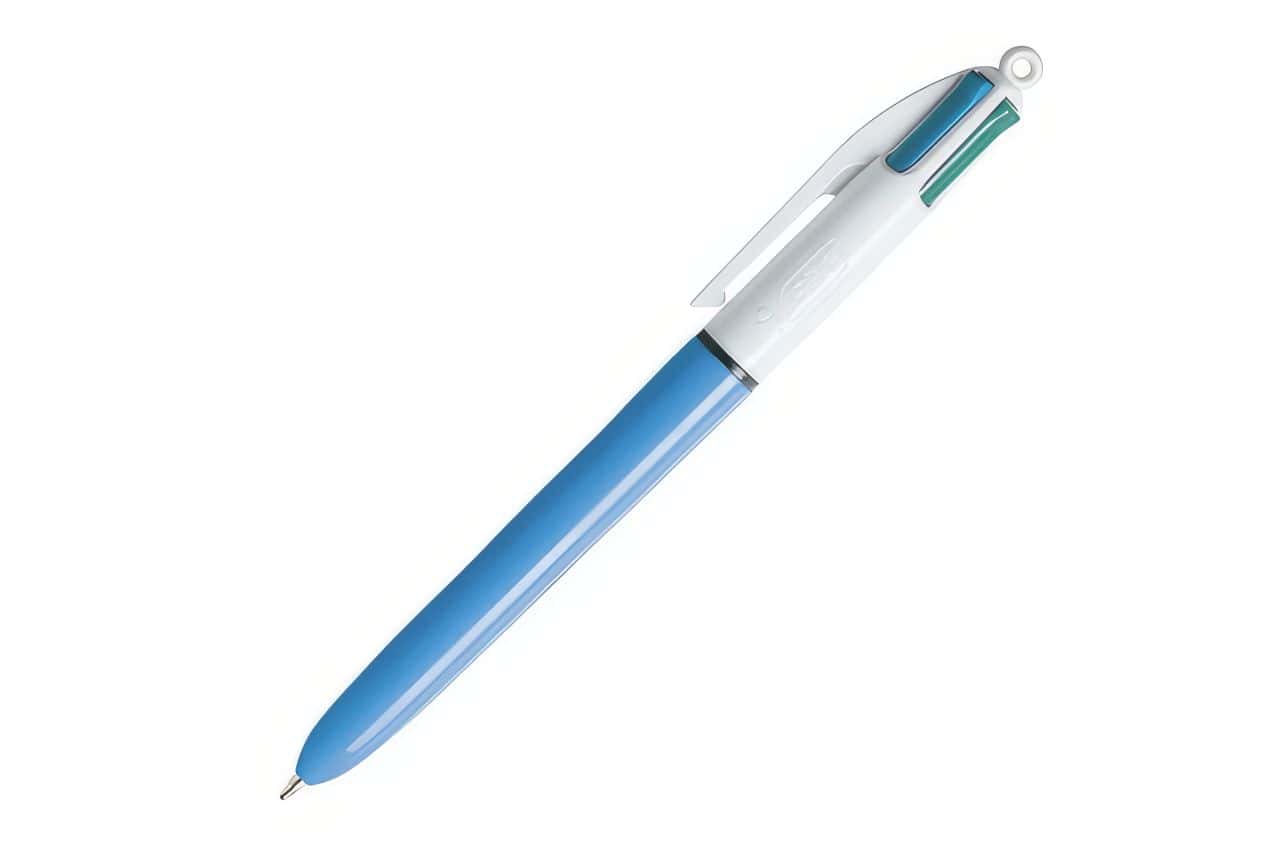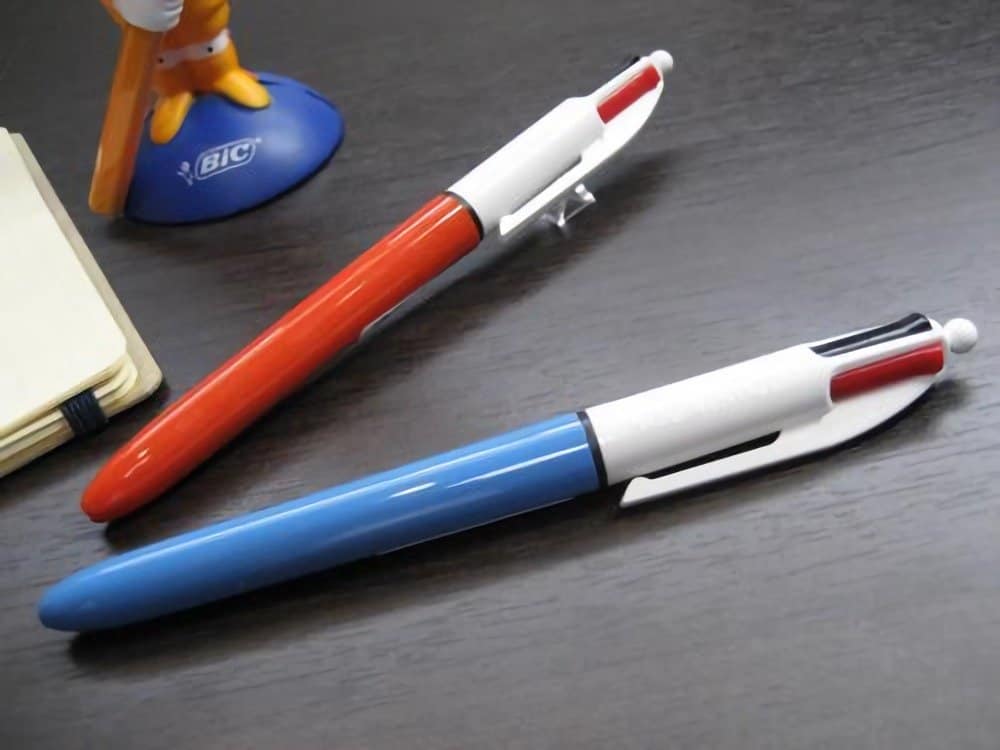Do you remember the magic of clicking a button and switching from blue to red ink in the same pen? For many of us, that little bit of wonder came from the one and only BIC 4-Color Pen.
Launched way back in 1970 by the visionary Marcel Bich, this simple stationery tool became a global icon. It wasn’t just a novelty, it was a game-changer for students, nurses, and anyone who loved to keep their notes organized. Its clever design and affordable price tag completely changed how we think about writing.
So, let’s click in and explore the incredible 50-year journey of this beloved pen!
Key Takeaways
The BIC 4-Color Pen was invented in 1970 by Marcel Bich to simplify writing for students and professionals by offering four ink colors in one device.
Its immediate popularity was due to its practicality for color-coding, making it a favorite for nurses organizing charts and students structuring notes.
The pen’s design, including the iconic BIC Boy logo on the white ball, is a symbol of French innovation and is still manufactured in France at a rate of 300,000 units per day.
Over 50 years later, the BIC 4-Color Pen remains a cultural staple, with limited editions and new designs keeping its appeal strong across generations.
The Birth of the BIC 4-Color Pen

The story of the iconic BIC 4-Color Pen begins in 1970, born from the mind of Marcel Bich. Following the massive success of the BIC Cristal, his team aimed to solve another common problem: the need to carry multiple pens for different tasks.
“Change the ink colour without changing the pen,” went the slogan.
https://plastics-themag.com/The-4-colour-BIC:-a-timeless-50-year-old-pen
The mission was clear. They needed a single pen that was compact, reliable, and affordable. The result was an ingenious design built around a simple spring-based mechanism that let you switch colors with a satisfying click. An early advertisement in France highlighted its value, boasting “4 colours for only 3 francs.”

Initially seen as a fun novelty, people quickly discovered its incredible utility. The pen’s feather-light design and distinct click made it a global sensation after its U.S. debut in 1971, forever changing the way we organize our thoughts on paper.
“The BIC 4-Color Pen, with its ability to switch between ink colors, revolutionized the way we write, making it a timeless classic in the world of writing instruments.”
Delving into the Unique Design of the 4-Color Pen
What makes the BIC 4-Color Pen so special? It’s a perfect blend of simple mechanics and thoughtful features that have stood the test of time.
- Simple, Smart Mechanism: The magic is in its gravity-assisted mechanism. When you press a colored slider, it pushes the corresponding ink cartridge down and into the writing position. Pressing another slider releases the first one, letting a spring retract it. It’s an elegant and durable solution.
- Compact and Lightweight: To fit four ink cartridges, the pen is slightly wider than a standard ballpoint, but it remains incredibly light. This makes it comfortable to hold and easy to carry, replacing the need for four separate pens.
- Durable Construction: The pen’s body is typically made from tough polystyrene plastic, built to withstand the thousands of clicks and constant use of daily life.
- The Iconic Click: That distinct sound is part of the pen’s charm. It’s a small, satisfying confirmation that your color is ready, making the simple act of writing a little more engaging.
These core design elements are why the BIC 4-Color Pen remains a go-to tool for anyone who needs a reliable, multi-functional pen for their daily tasks.
Varieties and Evolution of the 4-Color Pen
While the classic blue-barreled design is timeless, BIC has never stopped innovating. The 4-Color Pen family has expanded over the years to meet new tastes and needs.
New Designs and Textures
BIC regularly releases limited-edition collections with unique barrel designs and colors. These have become collector’s items, especially among students in France. You can find versions with fun patterns or sophisticated finishes.
- BIC 4 Colours Decors: Features trendy designs like “Space” and “Tie Dye” on the barrel.
- BIC 4-Color Bicolor: Offers a sleek, modern look with a glossy metallic effect combining two colors.
Expanded Versatility
The pen’s functionality has also evolved. Recognizing that users’ needs change, BIC introduced models that go beyond the four classic inks.
The most popular evolution is the BIC 4-Color 3+1, which includes the standard black, blue, and red inks but replaces the green ink with a 0.7mm mechanical pencil. This innovation makes it an all-in-one tool for both writing and sketching.
In a 2021 collaboration, BIC partnered with French artist Richard Orlinski and jeweler Tournaire to create luxury versions of the pen, including a bronze-plated model priced at 390€ and ultra-limited editions made of gold and diamonds.
These variations show how a classic design can adapt and stay relevant for decades.
The Enduring Appeal and Quality of the 4-Color Pen
Why has the 4-Color Pen remained so popular for over 50 years? Its appeal comes from a combination of quality, cultural significance, and undeniable practicality.
- A French Icon: The pen is a symbol of French innovation and is still proudly made in France. The main factory, located in Montévrain, produces around 300,000 units every day.
- Built to Last: Each 4-Color Pen is designed to write for an average of 8 kilometers (about 5 miles). This incredible durability makes it a reliable tool you can count on.
- Museum-Worthy Design: While the 4-Color pen is a daily tool, its predecessor, the BIC Cristal, is celebrated for its industrial design and is part of the permanent collection at New York’s Museum of Modern Art (MoMA).
- Global Reach: The pen is sold in over 160 countries, making it one of the most recognizable French products in the world.
‘From the bustling fashion streets of Paris to the desks of writers worldwide, the 4-Color Pen continues to make its mark. It’s more than a pen; it’s a symbol of enduring French craftsmanship and global appeal.’
The Artistry Behind the 4-Color Pen’s Palette
The choice of red, green, blue, and black ink wasn’t random. Each color serves a practical purpose, which is a key reason for the pen’s success in professional and academic settings.
Color-coding is a proven method for improving memory and organization. By assigning different colors to different topics, you create visual cues that help your brain categorize and recall information more efficiently. This is why the pen became an instant hit with students and professionals.
- Red: Perfect for making corrections and edits. It stands out on the page, making it the go-to color for teachers and editors who need to draw attention to important changes.
- Green: Often used for financial markups or secondary comments, green provides a clear alternative to red, allowing for another layer of organization.
- Blue: A standard for official signatures, blue ink is easily distinguishable from black photocopies, which helps in verifying original documents. It’s also a popular choice for everyday note-taking.
- Black: The universal color for official documents and long-form writing. Black ink is prized for its longevity and resistance to fading over time, conforming to ISO standards for documentary use.
By including these four foundational colors, the pen became a complete organizational system in a single, convenient package.
Dive into the Art of 4-Color Pen Manufacturing
The manufacturing process for the 4-Color Pen is a marvel of precision engineering, a secret BIC has perfected for over 50 years. The main operations take place at a high-tech factory in Montévrain, France, just a few kilometers from Disneyland Paris.
A Self-Contained Process
BIC controls the entire manufacturing process in-house to ensure quality. This is a key part of their strategy and includes:
- Making Their Own Ink: BIC develops and produces its own ink formulas, ensuring a consistent, smooth flow.
- Crafting the Ballpoint: The tiny tungsten carbide ball in the pen’s tip is made with incredible precision, using techniques borrowed from Swiss watchmaking.
- Molding the Body: The durable plastic components are molded on-site to form the pen’s sturdy and lightweight body.
Precision and Quality Control
Assembling the pen’s complex mechanism requires automated production lines that run 24 hours a day. Before being packaged and shipped worldwide, each pen undergoes strict quality control to meet the high standards BIC is known for.
The next time you use a 4-Color Pen, remember the incredible journey of engineering and craftsmanship that fits into the palm of your hand.
Unveiling the Creator of the 4-Color Pen
The mastermind behind the 4-Color Pen was Marcel Bich, the co-founder of BIC. While the company often credits its success to an “internal team,” Bich’s vision was the driving force behind this and many other iconic products.
- A History of Innovation: Bich was an Italian-born French citizen who co-founded his company in 1945. He first revolutionized the writing world by acquiring the patent from László Bíró and perfecting the ballpoint pen, leading to the launch of the BIC Cristal in 1950.
- The BIC Boy: The famous “BIC Boy” logo, the little figure with a ballpoint head, was created in 1961 by the acclaimed French graphic designer Raymond Savignac. The white ball at the top of the 4-Color pen is designed to represent the BIC Boy’s head.
- A Simple Goal: Marcel Bich’s ambition was always to create high-quality, reliable, and affordable products. The 4-Color Pen was the perfect embodiment of this goal, offering maximum function for a low price.
Although BIC protects the specific details of its design process, Marcel Bich’s legacy as a pioneer of industrial design is undeniable.
Personal Experiences and Affiliations
More than just a writing tool, the BIC 4-Color Pen creates a strong sense of loyalty and even nostalgia among its users. It’s a dependable partner for professionals who rely on organization.
For example, journalists have long used the pen to organize their notes. In a 2000 article for The New York Times, journalist Rick Marin explained his system: “blue for work-related entries; red for personal; black for illness… green for miscellaneous ‘creative projects’.” This method allows for quick, at-a-glance organization that digital tools sometimes can’t match.
Nurses and other medical professionals also swear by it. The ability to switch colors instantly is perfect for updating patient charts, where different shifts or types of information need to be clearly distinguished. Similarly, Dr. Mark Nethercote, a physician, highlights the pen’s reliability and honest design as a reason he keeps a stock of 20 on hand.
These stories show how a simple, well-designed product can become an indispensable part of people’s daily lives and professional routines.
| User Group | Primary Use Case | Benefit |
|---|---|---|
| Journalists | Organizing interview notes and daily planners | Quickly categorize topics for faster writing |
| Nurses/Doctors | Updating patient charts and medical records | Distinguish between shifts or data types |
| Students | Taking class notes and studying | Improve memory recall and organize subjects |
People Also Ask
What Is the Meaning Behind the White Ball on Top of the BIC 4-Color Pen?
The white ball on top of the BIC 4-Color Pen represents the head of the BIC Boy, the brand’s iconic logo. The logo was designed by Raymond Savignac in 1961.
How Did the BIC 4-Color Pen Gain Popularity Among Students and Nurses?
The BIC 4-Color Pen became popular with students and nurses because its different colors are perfect for organizing information. Students use it to separate subjects in their notes, which can improve memory, while nurses use it to color-code patient charts by shift or data type.
Who invented the BIC 4-Color Pen?
The pen was invented in 1970 by a team at BIC led by the company’s founder, Marcel Bich. He was the visionary who drove the company to create simple, affordable, and reliable products.
Is the BIC 4-Color pen refillable?
While the classic BIC 4-Color pen was designed to be disposable, many of the modern versions are refillable. You can buy replacement ink cartridges to extend the life of your pen, which is a more sustainable option.
How many pens does the BIC factory in France produce?
The BIC factory located in Montévrain, France, is a state-of-the-art facility that produces approximately 300,000 BIC 4-Color pens every single day.

I first got one of these pens in the 1970’s and have loved them ever since. One good use I have found is to write my shopping list in black, then I cross the things off in red as I go round the shop. If the item is out of stock I cross it off with blue.
A point about fountain pens: although you *could* change the ink it was a messy job to get the old ink back in the bottle, and then you would have to flush the pen to remove all traces of the old ink before filling with the new colour. In practice this was very rarely done as it was such a hassle, two or more pens would be used if you needed to change colours often.
You know? I love them too. They’re a little bit nerdy, but I’m OK with that.
Something seems wrong, here. I think I recall having one in the 60s,
Yes! I agree. I bought one in the early 60s at the Statue of Liberty.
Just bought one today. Glad to remember my school days!
I recall having a few of those four-color pens, first in the 1970s and then afterward, probably into the late 1980 or early 1990s, in fact ones just like the blue and white one shown in the photograph on this webpage. The pens were manufactured by BIC, just as indicated by the logo in the photo here.
But my very first multi-color pen, given me as a Christmas gift, was a big thick one with chambers for holding many ballpoint cartridges, must have been a 10 or 15-color pen. Does anyone remember having and/or seeing those types of multicolor ballpoint pens? My recollection of that one is its casing was half orange-colored.
I still have a fondness for multi-color pens, just as I also do for those LifeSavers books of candies one usually received as stocking stuffers at Christmastime. These are the types of items one doesn’t usually purchase for oneself, but is sure appreciative to receive as a gift.
Thanks for the memory, GeekExtreme.com
I’ve owned a few of these 10 color pens. They seemed to be more of novelty then a practical use thing. I saw some being sold in 4-packs at Walmart in the party-favors section a few years back. They are also not same build quality as the Bic 4 color…
I had one of those ten color pens. Got it for Christmas in the mid 70s. I remember it was junk and nowhere near the quality of the 4 color Bic.
These 4 color Bic, I emphasize BIC pens, have been a part of MY life since they became available !
While managing an art gallery, I issued these to all of my employees along with CLEAR instructions as to what each color represents!
In short, these pens helped them become more efficient, AND accurate !! 😉
I mainly used Bic Pens over the years, since the 1970s, including Wild Blue, when it was advertised on TV around 1977, in a commercial featuring American Indians. I remember those huge triangular-shaped pens some kids had at school also. We could buy a new pen at the toy shop near where we lived in Christchurch, New Zealand for 23 cents in 1977. I recall the four colour pen, but did not start using it until 1994, and have done so for the most part ever since – Bic is the most reliable and popular brand. I note though that recently (say fifteen or so years ago), the white knob at the top of the Bic four colour pen changed to a white ring – perhaps to thread a string through it to carry around the neck, but it seems too small for that. There was a movie set in 1994, but the lady had the new style pen in that, which was not around then, since the film was made round 2011. Other brands are cheaper, but sometimes the ink does not flow steadily, and when one opens up the pen to look at the ink levels, if the pen is turned upside down, everything falls out – not so with the Bic – there are other quality brands, but Bic in my opinion is the best.